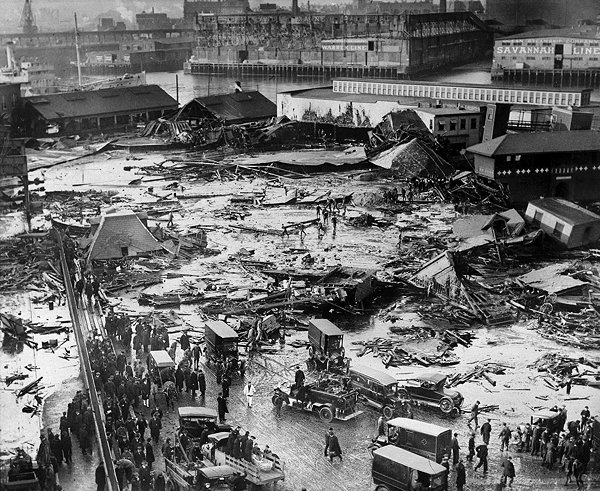Science of the Great Molasses Flood

The Boston Molasses Flood of 1919 is one of the great weird news stories of all time. It was a tragedy (21 people killed), but also definitely weird.
What happened in brief: A tank holding 2.3 million gallons of molasses burst, causing a 40-foot tsunami of molasses to flood through Boston's North End.
Exactly why the tank burst and why the flood proved so deadly has always been a bit of a mystery. But now scientists have done their thing and have come up with a few answers. As reported in the New York Times (Nov 26, 2016), interviewing aerospace engineer Nicole Sharp:
"The historical record says that the initial wave of molasses moved at 35 miles per hour," Ms. Sharp said, "which sounds outrageously fast."
"At the time people thought there must have been an explosion in the tank, initially, to cause the molasses to move that fast," she added. But after the team ran the experiments, she said, it discovered that the molasses could, indeed, move at that speed.
"It's an interesting result," Ms. Sharp said, "and it's something that wasn't possible back then. Nobody had worked out those actual equations until decades after the accident."
If the tank had burst in warmer weather, it would have "flowed farther, but also thinner," Mr. Rubinstein said.
In the winter, however, after the initial burst — which lasted between 30 seconds and a few minutes, Ms. Sharp said — the cooler temperature of the outside air raised the viscosity of the molasses, essentially trapping people who had not been able to escape the wave.
"At the time people thought there must have been an explosion in the tank, initially, to cause the molasses to move that fast," she added. But after the team ran the experiments, she said, it discovered that the molasses could, indeed, move at that speed.
"It's an interesting result," Ms. Sharp said, "and it's something that wasn't possible back then. Nobody had worked out those actual equations until decades after the accident."
If the tank had burst in warmer weather, it would have "flowed farther, but also thinner," Mr. Rubinstein said.
In the winter, however, after the initial burst — which lasted between 30 seconds and a few minutes, Ms. Sharp said — the cooler temperature of the outside air raised the viscosity of the molasses, essentially trapping people who had not been able to escape the wave.
Comments
When I first saw this story some twenty years ago I was a bit incredulous. I was surprised that the destruction was not worse than reported.
One would expect that those engineers, who probably deal with fluid dynamics in their line of work, would be a bit less incredulous of the reported 35 m.p.h. flow rate of such a large viscous mass.
One would expect that those engineers, who probably deal with fluid dynamics in their line of work, would be a bit less incredulous of the reported 35 m.p.h. flow rate of such a large viscous mass.
Posted by KDP on 11/28/16 at 02:27 PM
You are correct, KDP. 35 MPH did not seem "outrageously fast" at all to me -- nor would any other speed within reason. It needs to be demonstrated empirically or calculated first. The speed just depends on the storage temperature, the height of the liquid in the tank (40 ft, apparently), and an assumption about how the tank burst. Perhaps there are different purities of molasses that need to be accounted for. The NY Times may have asked the wrong type of engineer. Just the facts, please, ma'am.
Posted by Virtual on 11/28/16 at 08:33 PM
Commenting is not available in this channel entry.

Category: Disasters | 1910s